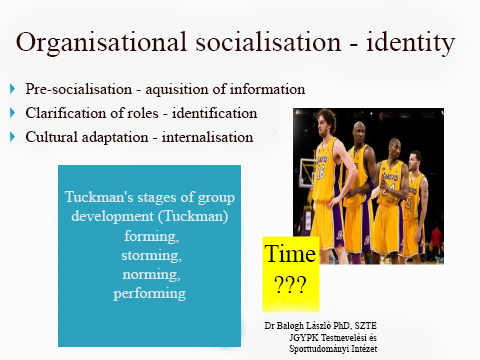Organisational socialisation
In lucky cases, the emergence of an individual’s affective commitment to an organisation precedes his introduction to the organisation. Of course, the whole process is affected by the way one gets into an organisation. Most studies have found that the harder it is for applicants to become hired, i.e. through “challenging tests”, the more committed they become. These new employees value their new positions better than those getting a job by pure chance. It is not accidental then that applicants are tested in several distinct phases by headhunters/recruiters or the human resources staff of the organisation where they would like to work. Applicants are not only tested for professional knowledge or personal abilities, but they also undergo serious psychological tests, which is basically an early phase of organisational socialisation.
A similar procedure takes place at sports organisations too, which include trial games and careful medical check-ups during which – if everything goes well – unaware athletes start getting to know the new club they are to be hired by. After the transfer of an athlete, however, the process of organisational socialisation accelerates, and a new member becomes informed about the club’s organisational structure at once.
As detailed in a previous chapter, both written employment contracts and unwritten psychological contracts are concluded at the same time when a new player joins an organisation. It is often mentioned that right before the start of their work, fresh members get the opportunity to become acquainted with their new employer. For instance, newcomers at the Los Angeles Lakers receive a so-called playbook, which involves a compilation of basic strategies the team would like to use during games. What is more, the book also contains all the important information on the club, such as its history, structure, hierarchy, traditions, and the way it works. Every club should follow this example and publish a book like this, which would be of great use to new players who need lots of information on the club and help in the beginning. In this way, they might also learn whom to ask when they need help to cope with certain problems. Additionally, if we think it over, there may be several individuals coming from other cultures who would be grateful to receive such publications, not mention the psychological advantages of the feeling of being taken care of by one’s club.
Figure 13 represents the process of organisational socialisation.

Figure 13: The process of organisational socialisation
When entering an organisation, newcomers start to familiarise themselves with their new workplace; however, there are cases when this process already begins in the form of pre-socialisation, which helps new members to fit in. Newly employed individuals get to know the culture, values, norms, rules of the organisation, as well as the way it works, and who they can turn to. This process can be speeded up by, for example, taking part in training camps, club events, etc. Following the completion of the first phase of socialisation, one is ready to occupy his new role in the organisation and identify with the same. Then, after a while, if everything goes well, a new member does not only identify with his new workplace but also becomes a follower who completely accepts and agrees with the organisation’s values, norms, and goals.
The phases described above are similar in many aspects to Tuckman’s stages of group development (see Nagykáldi, 1998), which include four phases necessary for a group to turn into a well-functioning one. During the first phase, also known as forming, new members are eager to show their best behaviour, making a good impression on others. After a while, however, conflicts might arise among/between group members, who all “fight for” fulfilling an important role in the organisational hierarchy. This is the phase of storming. If members manage to resolve their differences, the stage of norming begins when every individual has his own place, role, or status within the group. Finally, when arriving at the stage of performing, the team is ready to function in an appropriate way, making every attempt to perform at its best. Time is required for teams to go through these stages. One should never expect a newly employed member to put in an excellent performance immediately. Newcomers need our help with fitting in, and experts should be aware of every detail.